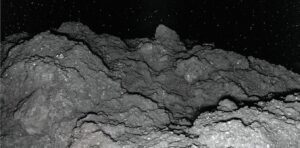

Mark Clampin, director of the Astrophysics Division at NASA Headquarters, accepts the 2023 Michael Collins Trophy for Lifetime and Current Achievements from Christopher Browne, John and Adrienne Mars Director of the Smithsonian’s National Air and Space Museum. The trophy was awarded to the team behind NASA’s James Webb Space Telescope in a ceremony at the museum’s Steven F. Udvar-Hazy Center in Chantilly, Virginia, on March 23, 2023. Credit: Smithsonian’s National Air and Space Museum
NASA’s James Webb Space Telescope team was selected to receive the 2023 Michael Collins Trophy for Lifetime and Current Achievements. This annual award from the Smithsonian’s National Air and Space Museum honors outstanding achievements in the fields of aerospace science and technology, and their history.
“The James Webb Space Telescope team’s dedication and ingenuity is an inspiration to the world,” said NASA Associate Administrator Bob Cabana. “The partnerships that make this mission possible represent the best of humanity and are critical to enabling us to use Webb to understand our universe better.”
The award was presented during a ceremony at the museum’s Steven F. Udvar-Hazy Center in Chantilly, Virginia, on March 23.
“The 2023 Collins Trophy recipients have helped humans understand their place on this Earth,” said Chris Browne, the John and Adrienne Mars Director of the museum. “The James Webb Telescope has likewise given us new perspectives on the universe.”

James Webb Space telescope. Credit: NASA’s Goddard Space Flight Center Conceptual Image Lab
Launched on December 25, 2021, Webb is the largest and most powerful space science telescope ever built. In July 2022, the Webb team officially began Webb’s mission to explore the infrared universe.
“Congratulations to the James Webb Space Telescope team for pushing the boundaries to reveal our history through the earliest, most distant galaxies that shine in the cosmos,” said Nicola Fox, associate administrator for the Science Mission Directorate at NASA Headquarters. “The awe-inspiring images and spectra are already delivering on Webb’s promise to unlock a new era of science.”
With its optics performing nearly twice as well as the mission required, Webb is discovering some of the earliest galaxies ever observed, peering through dusty clouds to see stars forming, and delivering a more detailed view of the atmospheres of planets outside our solar system than ever before. Webb has also captured new views of planets within our solar system, including the clearest look at Neptune’s rings in decades. The Collins Trophy award recognizes the extraordinary accomplishments and significant contributions of the team members who designed, developed, and now operate the Webb mission.

The luminous, hot star Wolf-Rayet 124 (WR 124) is prominent at the center of the James Webb Space Telescope’s composite image combining near-infrared and mid-infrared wavelengths of light from Webb’s Near-Infrared Camera and Mid-Infrared Instrument. Credit: NASA, ESA, CSA, STScI, Webb ERO Production Team
“The James Webb Space Telescope is allowing us to study a time when the first stars and galaxies formed in the universe. This amazing achievement has been made possible over many years by the dedication of the thousands of people on the team, who have pushed the boundaries of technology to deliver this spectacular space telescope,” said Mark Clampin, director of the Astrophysics Division for the Science Mission Directorate at NASA Headquarters. Clampin delivered remarks after accepting the 2023 Collins Trophy on March 23, on behalf of the Webb team.
Winners receive a trophy featuring a miniature version of the “Web of Space” sculpture, which was created by John Safer from Washington, D.C. The award was established in 1985 and was renamed in honor of Apollo 11 astronaut Michael Collins in 2020.
Webb, an international mission led by NASA with its partners ESA (European Space Agency) and CSA (Canadian Space Agency), is the world’s premier space science observatory. Its design pushed the boundaries of space telescope capabilities to solve mysteries in our solar system, look beyond to distant worlds around other stars, and probe the mysterious structures and origins of our universe and our place in it.
Recently, the Webb mission’s accomplishments also have been recognized by organizations including the Space Foundation, Science, National Space Club and Foundation, Aviation Week, Bloomberg Businessweek, Popular Science, and TIME.

